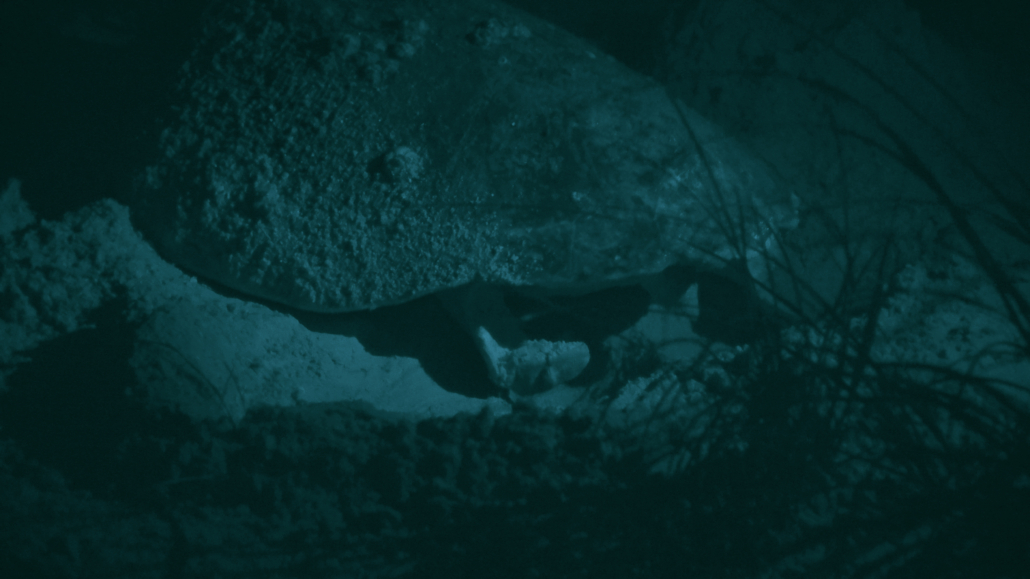Sasha Wortzel: Dreams of Unknown Islands

Sasha Wortzel, “Dreams of Unknown Islands,” installation view [photo: Pedro Wazzan]
Share:
Sasha Wortzel’s Sitting Shiva (2021), which consists of two folding lawn chairs whose webbing has been replaced with Burmese python skins, suggests strategies for reusing the remains of an invasive reptile. The title phrase, “sitting shiva,” refers to a weeklong Jewish mourning period, a ritual that understands personal loss as a time of individual shock and communal healing. As such, these twin chairs seem predicated upon grief: for the apex predator pythons’ impact on already-endangered species in South Florida, and for the vacant chairs’ suggestion of an absent couple. Wortzel’s Sitting Shiva is central to the exhibition’s—and the artist’s—attentiveness to life’s fragility during a precarious time.
Dreams of Unknown Islands, the result of Wortzel’s residency at Oolite Arts, takes its title from Marjory Stoneman Douglas’ 1947 proto-environmentalist book, The Everglades: River of Grass. Douglas’ keen attention to the human-induced impacts on the Everglades’ fragile ecosystem inflects the exhibition, but the show is likewise bracketed by Audre Lorde’s “A Litany for Survival” (first published in 1978), which Wortzel selected for display in the gallery’s foyer. Lorde’s poem begins with the line, “For those of us who live at the shoreline,” a phrase Wortzel appropriated for the titles of three videos in the exhibition, each with a distinct subtitle: sunrise, sunset, and sea turtle labor (all dated 2020). Lorde continues, “And when the sun rises we are afraid / it might not remain / when the sun sets we are afraid / it might not rise in the morning”—a passage relayed by the imagery in this suite of videos. sunset is placed in a room of its own, and the silent video projects, onto a wall, our yolky star disappearing into the Gulf of Mexico, off Florida’s west coast. sunrise is paired with sea turtle labor. The former (evoking Lorde’s lines) keeps the sun endlessly reverberating up and down, just above the horizon. The latter, though, seeks other rhythms. Silent, as are the other videos in this triptych, sea turtle labor depicts a nesting turtle on a moonlit night and conveys a visceral awareness of labor’s dual meanings. The video documents a mother digging her body pit, laying her eggs, and, at times, resting in utter exhaustion, while surrounded by sea grass whipping in the wind. Offering occasional glimpses of proximate human habitats (lights in the distance), For those who live at the shoreline (sea turtle labor) is a chronicle of the toil of perseverance.
For those who live at the shoreline (sunset), 2020, video, color, silent, 5:21 min
For those who live at the shoreline (sunrise), 2020, video, color, silent, 1:01 min.
For those who live at the shoreline (sea turtle labor), 2020, video, color, silent, 16:01 min.
Although Wortzel’s videos are silent, and shown in darkened rooms adjacent to Oolite’s main gallery, all of the gallery’s spaces are filled with Wortzel’s sound sculpture Dreams of Unknown Islands (2021). Seven 3-D–printed white polymer shells hang from the ceiling in the main space, each concealing a speaker that projects different tracks of the looping sound work, all eventually resolving into a singular score. The exhibition’s curator, Kristan Kennedy, describes the sound as “seashell resonance,” the noise one hears when holding a seashell to the ear. Wortzel combined numerous sounds for the piece, including underwater recordings collected along Florida’s Gulf Coast, and the sounds of friends and family reciting the Kaddish, a 13th-century Aramaic prayer intended as a song for collective mourning and healing. With these notes and tones combined, Dreams evokes the din of human voices cutting through wind and sea swell, a murmur that is at once trancelike and ceremonial.
Wortzel’s insistence on ritual and contemplation throughout the exhibition might be symptomatic of having completed these projects during the pandemic.
Sasha Wortzel, “Dreams of Unknown Islands,” installation view [photo: Pedro Wazzan]
As the United States enters a period of relative reprieve from Covid-19, questions remain as to how, when, or where we will grieve for the lives lost during this tragedy. Attempts at such grief have been rendered isolated, their pain intensified by simultaneous mourning for victims of racial terror, gun violence, and socioecological degradation. Wortzel’s work, marked with signs of grief and hope, posits ways to reimagine the art-historical iconography of lamentation. One cannot escape, in this regard, how Wortzel’s Sitting Shiva resonates with the work of another artist, Félix González-Torres, who passed away in Miami 25 years ago (this anniversary is the subject of an exhibition at the nearby Bass Museum of Art). Wortzel’s coupled chairs recall the late artist’s Untitled (1991) billboard project, which depicts an empty bed, its paired pillows left with the indentations of two now-absent bodies. Made during a different pandemic, one equally riddled with public health inequities, González-Torres’ work is archetypal in this context. Wortzel’s Dreams of Unknown Islands presents ways of thinking through grieving that are equally astute, invigorated by moments of restorative communion that one might hope will define the year to come.
Chris Balaschak is Associate Professor of Visual Arts at Flagler College in St. Augustine, FL, where he teaches courses on visual culture, modern and contemporary art, curatorial studies, and the history of photography. His research considers photography’s role in exposing and scrutinizing place-based politics. Balaschak’s book, The Image of Environmental Harm in American Social Documentary Photography, explores how American photographers responded to the environmental consequences of federal infrastructure throughout the 20th century.



